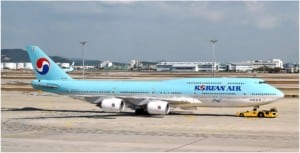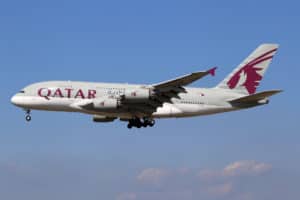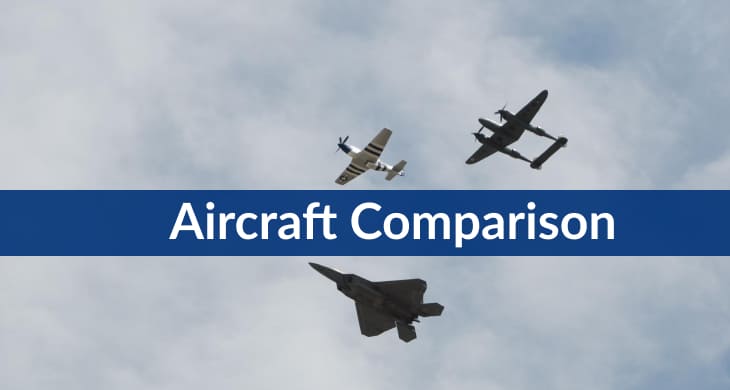The two biggest passenger jets in the sky are in line with quite a few differences. This blog post will pit 747 vs A380 against each other in a battle to see which giant jet is superior.
| Aircraft: | Boeing 747-8 | Airbus A380-800 |
|---|---|---|
| Photo: |
 |
 |
| Country: | United States | France |
| Manufactured: | from: 2008 to: Present | from: 2007 to: Present |
| ICAO: | B748 | A380 |
| Price: | $418.4 million | $445.6 million |
| Avionics: | Rockwell Collins Avionics | Thales Rockwell Honeywell Combo |
| Engine: | 4x General Electric GEnx 2B67 | 4x Engine Alliance GP7270 or Rolls-Royce Trent 900 |
| Engine Type: | Turbofan | Turbofan |
| Power: | 66,500 pound-force | 81,500 pound-force |
| Max Cruise Speed: |
533 knots 987 Km/h |
587 knots 1,087 Km/h |
| Approach Speed (Vref): | 145 knots | 135 knots |
| Travel Range: |
8,000 Nautical Miles
14,816 Kilometers |
8,000 Nautical Miles
14,816 Kilometers |
| Fuel Economy: |
0.12 nautical mile / gallon 0.059 kilometres / litre |
0.1 nautical mile / gallon 0.049 kilometres / litre |
| Service Ceiling: | 43,000 feet | 43,000 feet |
| Rate of Climb: |
2500 feet / minute 12.70metre / second |
1500 feet / minute 7.62metre / second |
| Take Off Distance: |
3190 metre 10,465.75 feet |
2749 metre 9,018.92 feet |
| Landing Distance: |
2680 metre 8,792.54 feet |
1524 metre 4,999.94 feet |
| Max Take Off Weight: |
447,696 Kg 986,991 lbs |
575,000 Kg 1,267,645 lbs |
| Max Landing Weight: |
312,072 Kg 687,994 lbs |
395,000 Kg 870,817 lbs |
| Max Payload: |
76,067 Kg 167,697 lbs |
87,000 Kg 191,800 lbs |
| Fuel Tank Capacity: |
63,034 gallon 238,609 litre |
85,472 gallon 323,546 litre |
| Baggage Volume: |
161.5 m3 5,703 ft3 |
190 m3 6,710 ft3 |
| Seats - Economy: | 467 seats | 853 seats |
| Seats - Business Class: | 600 seats | 480 seats |
| Seats - First Class: | 467 seats | 416 seats |
| Cabin Height: |
2.39 metre 7.84 feet |
3 metre 9.84 feet |
| Cabin Width: |
6.1 metre 20.01 feet |
6.58 metre 21.59 feet |
| Cabin Length: |
63.25 metre 207.51 feet |
50.68 metre 166.27 feet |
| Exterior Length: |
76.25 metre 250.16 feet |
72.73 metre 238.61 feet |
| Tail Height: | 19.51 metre - 64.01 feet | 24.27 metre - 79.63 feet |
| Fuselage Diameter: |
6.49 metre 21.29 feet |
7.14 metre 23.42 feet |
| Wing Span / Rotor Diameter: |
68.4 metre 224.41 feet |
79.75 metre 261.64 feet |
| Wing Tips: | Raked Wingtips | Wingtip Fences |
| More Info: | Boeing 747-8 | Airbus A380-800 |
|
Data presented is for entertainment purposes and should not be used operationally.
|
Other Boeing 747-8 comparisons:
Other Airbus A380-800 comparisons:
About the Boeing 747
The Boeing 747 is a wide-body airliner typically used for long-haul flights. It can seat up to 660 passengers, making it ideal for large groups or families traveling together.
With its spacious interior and impressive cargo capacity, the Boeing 747 is a popular choice for airlines and travelers alike.
Why was it developed and built?
The Boeing 747 was developed to meet the demand for a large commercial airliner. At the time, air travel was overgrowing, and existing aircraft could not keep up with the demand.
The 747 was designed to be much larger than any other airplane. To achieve this, Boeing engineers had to develop innovative solutions, including a new engine that could lift a heavier plane and a wide-body fuselage to accommodate more passengers.
What purpose does it serve?
The Boeing 747 is also commonly used for cargo flights, as it has large cargo. In addition, the plane can be easily converted to a freighter by removing seats and installing cargo doors. As a result, the Boeing 747 plays an essential role in passenger and cargo travel.
About the Airbus A380
The Airbus A380 is built by Airbus and is the world’s biggest travelers airliner. Likewise, the airports it runs on have advanced their accommodations to adapt it.
Why was it developed and built?
The plane was developed to meet the increasing demand for air travel and the need for airlines to operate more efficiently. It is powered by Engine Alliance GP7270 engines, which provide it with considerable fuel efficiency. The plane also features a unique design that allows it to land at smaller airports.
What purpose does it serve?
The Airbus A380 is a long-range, wide-body airliner used for international flights. It can carry up to 853 passengers and has a range of over 14,800 km.
It is the most efficient airliner in operation, with a fuel efficiency that is much better than other jets in its class. The A380 also has a large capacity for cargo operators, making it a popular choice.
How are the Boeing 747 and Airbus A380 different?
The two aircraft have some key differences.
Capacity
The 747 has a capacity of 660 passengers, while the A380 can carry up to 853 people. That’s a difference of 193 people or nearly 30%. The A380 wins this round easily.
Range
The 747 has a range of about 8,000 miles, while the A380 can fly for 9,200 miles. That’s only a 1200-mile difference. Although the A380 technically has a longer range, both planes can fly for over 24 hours non-stop, so they are neck and neck in this department.
Cargo Capacity
The cargo capacity of the Boeing 747 is 6,345 cubic feet, while the Airbus A380 can hold 6,190 cubic feet. This is close, but we have to give it to the Boeing 747 for that extra space.
Cruise Speed
The Boeing 747 has a cruise speed of around 0.855 Mach, while the Airbus A380 holds the same. That’s the same, so we will call it a draw. Now let’s jump over to the similarities.
How are the Boeing 747 and Airbus A380 similar?
With differences aside, there are some similarities between the two aircraft. Here are three of them.
The Boeing 747 and Airbus A380 are used for long-haul flights
The Boeing 747 was initially designed as a long-haul aircraft and is still primarily used for flights across oceans or to other continents.
The Airbus A380 was also designed for long-haul flights, and it is often used on routes between major global cities that see a lot of air traffic.
Both aircraft are double-deckers
One of the most distinctive features of the Boeing 747 and Airbus A380 is that they are double-deckers with a second set of wings and engines above the main cabin. This design allows for more passengers to be carried on board, as well as more cargo.
Both aircraft has four engines
Another similarity between the Boeing 747 and Airbus A380 is that they have four engines, which provides redundancy in case one or more engines fail during flight.
It also gives these aircraft the power to take off and land safely at busy airports worldwide.
What’s better about the Boeing 747?
The Boeing 747 is a large-capacity, wide-body airliner and has been continuously updated with the latest technology. Here are just a few of the reasons why it remains the king of the skies:
- Its size allows it to carry more passengers and cargo than any other aircraft.
- The Boeing 747 range is nearly 13,000 miles at the ceiling, making it ideal for long-haul flights.
- It features a unique “hump” design that gives it superior aerodynamic performance.
- The Boeing 747 is powered by four massive engines, making it one of the most powerful aircraft ever built.
- Its spacious cabin is outfitted with the latest in luxury amenities, making it a comfortable choice for high-end travelers.
- It remains the standard by which all other long-range airliners are measured.
What’s better about the Airbus A380?
The Airbus A380 is the world’s largest passenger airliner and offers many advantages over its smaller rivals. For example, the Airbus A380 has a wider fuselage, which allows it to accommodate more passengers and luggage.
It also has a more fuel-efficient engine design, which results in lower operating costs. In addition, the Airbus A380 is equipped with the latest flight deck technology, enhancing safety and efficiency. As a result, the Airbus A380 is well-suited for long-haul routes and quickly becomes the preferred choice of airlines worldwide.
Conclusion
Both are excellent aircraft for long-range travel! The Boeing 747 and Airbus A380 offer excellent performance and features, making them popular choices for airline companies.
Ultimately, it falls to the metrics against which they’re being compared and the mission or task of specific airline companies.


